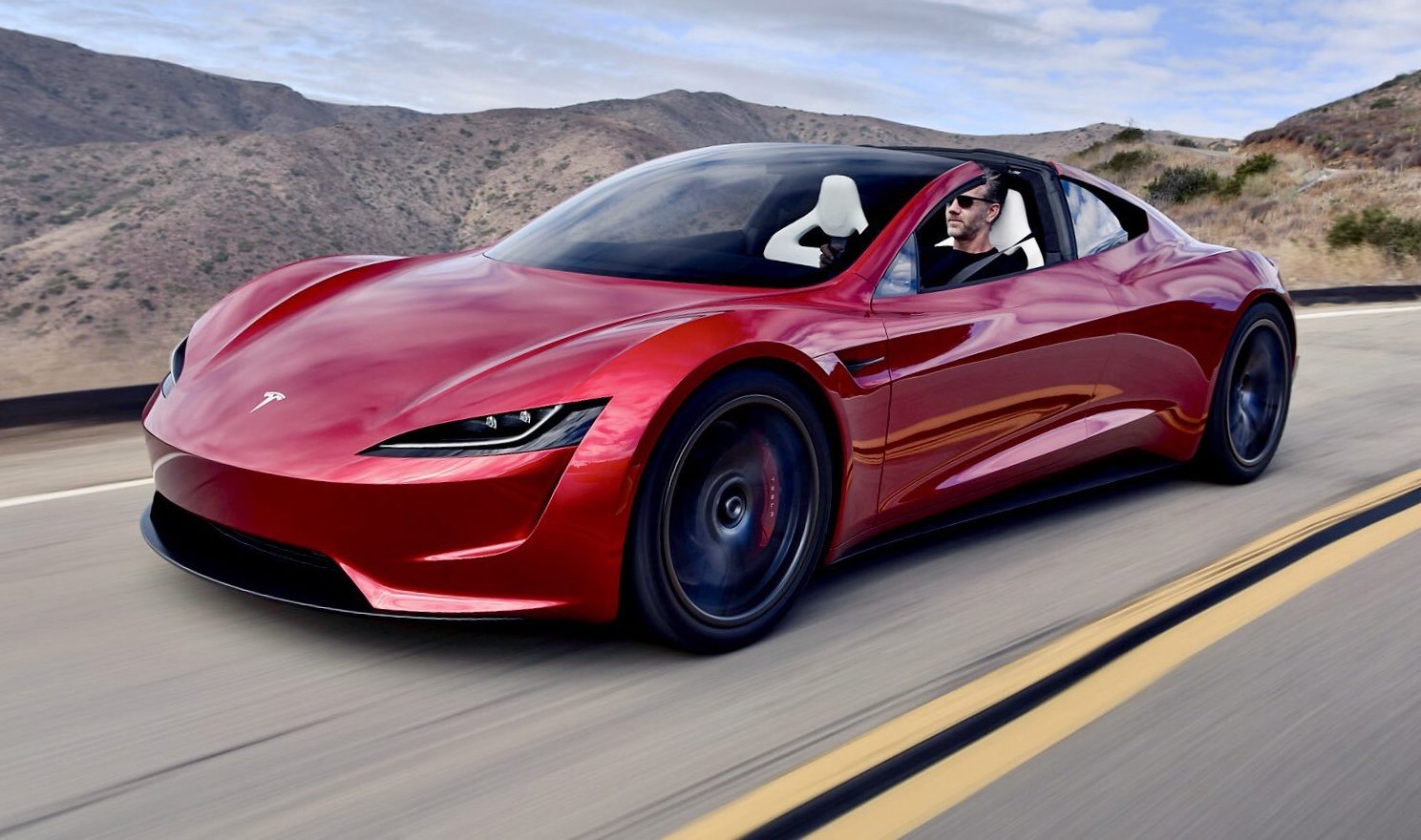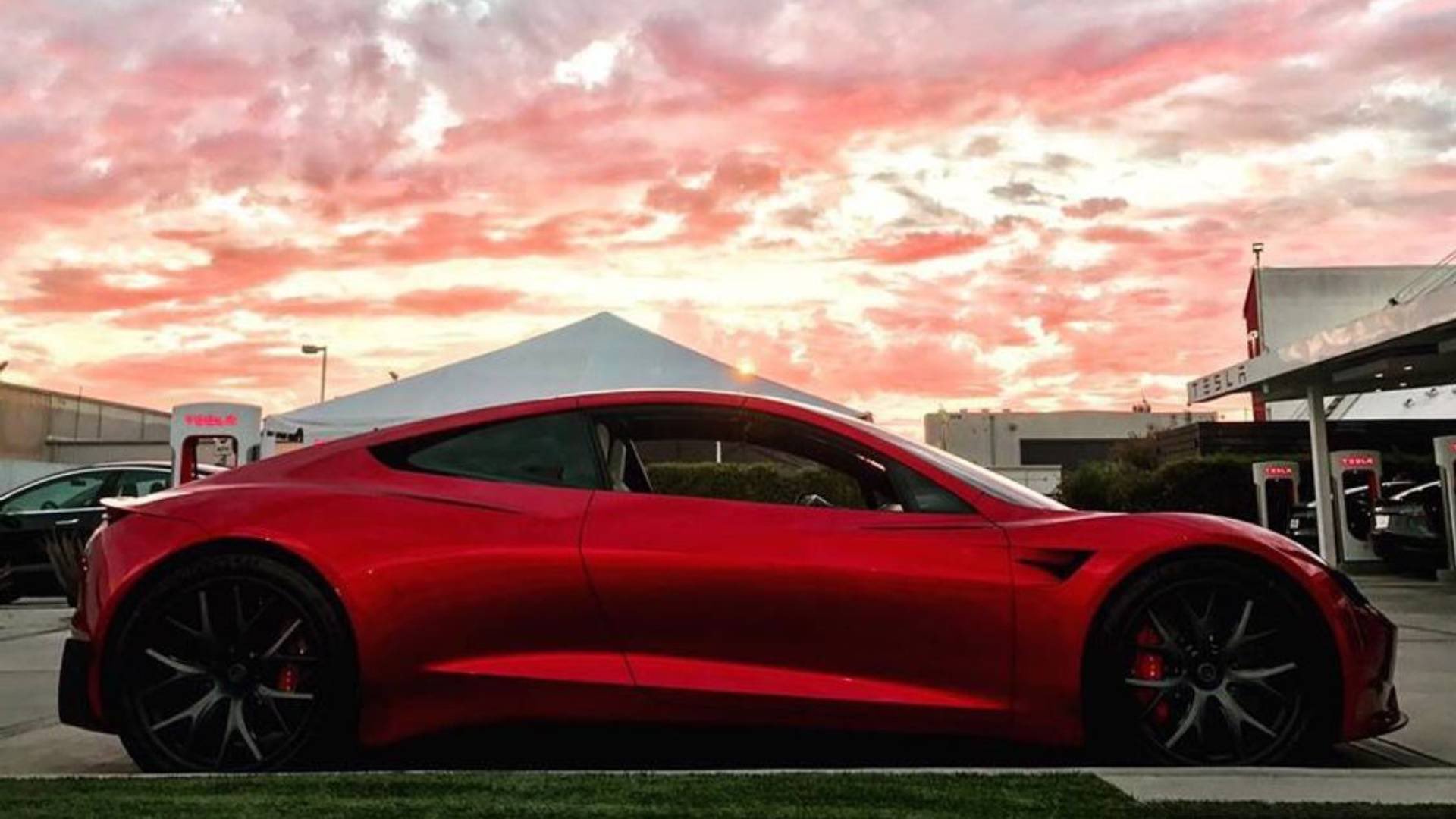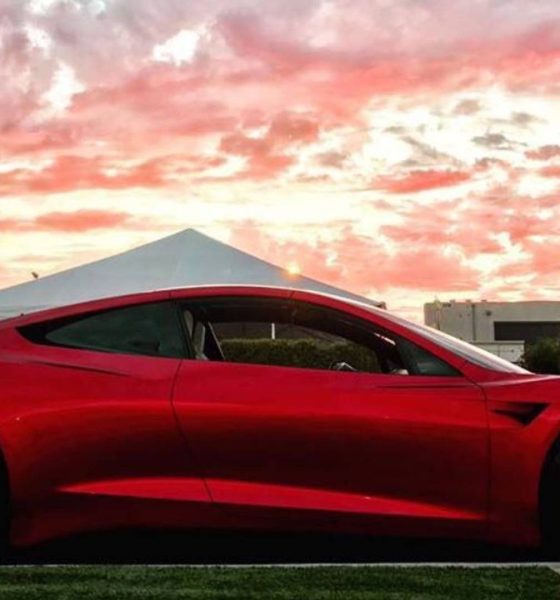The second edition of the Tesla Roadster was initially slated for production and delivery in 2020, but two years later, the car still has not been produced, and details are still slim. Here’s what we know about the next-gen Tesla Roadster.
Tesla CEO Elon Musk unveiled the next-gen Tesla Roadster in 2017 during the reveal event of the Tesla Semi. It was not expected, and Musk surprised everyone in the room when the new design was released to spectators. Since then, various details have been released but it still remains unclear when the vehicle will actually enter production.
The Roadster might be able to hover
Musk unveiled a potential SpaceX package for the Roadster in 2018, which would utilize SpaceX cold-gas thrusters to enable short-term hovering abilities. Tesla has reiterated this potential on several occasions, describing a potential 1.1-second 0-60 MPH acceleration time. It is still unclear whether the FAA will have anything to say about the vehicle’s potential hovering capability, but the 1.1-second 0-60 time would be Tesla’s fastest by a considerable margin, and one of the fastest on Earth.
The new Roadster will actually do something like this https://t.co/fIsTAYa4x8
— Elon Musk (@elonmusk) January 9, 2019
You can still reserve a Tesla Roadster
Tesla Roadster reservations are still available on Tesla.com. “Roadster reservations require an initial $5,000 credit card payment, plus a $45,000 wire transfer payment due in 10 days. Reservations are not final until the wire transfer payment is received,” Tesla describes. Founders Series Roadster reservations are closed.
Credit: Tesla
Production of the Tesla Roadster was expected to start in 2019, 2020, 2021, 2022, and now 2023
Production dates of the Tesla Roadster have shifted several times in the vehicle’s history. After production was expected to begin in 2019 with deliveries in 2020, Tesla shifted production to “the next 12 to 18 months” during the Q2 2020 Earnings Call. This pushed production to mid-2021 as the pandemic raged on and limited production output across the industry.
In January 2021, Musk once again delayed production to 2022, stating engineering on the vehicle was set to be completed late last year.
Finishing engineering this year, production starts next year. Aiming to have release candidate design drivable late summer. Tri-motor drive system & advanced battery work were important precursors.
— Elon Musk (@elonmusk) January 28, 2021
In late 2021, Musk once again delayed production to 2023 as long as Tesla could avoid “mega drama” with the supply chain in 2022. It is relatively unknown if 2022’s supply chain was “mega drama,” as the description is objective. However, there are a lot of indications Tesla could be ready to introduce some new products to its lineup next year.
The Cybertruck is ready to begin production early next year, and a low-volume vehicle like the Roadster could be a great test of Tesla’s resilience and supply chain health if it can begin manufacturing the supercar in 2023.
The Tesla Roadster will likely be built in California
Tesla will likely build the vehicle in California.
“We think, probably, also the Tesla Roadster, a future program, would also make sense in California,” Musk said during the company’s Q2 2020 Earnings Call.
Fremont is the only plant that currently builds all four Tesla models, and it continues to manufacture low-volume vehicles like the Model S and Model X, which only make up a small percentage of the company’s overall deliveries each quarter. Fremont is space-confined, but filings and other plans have indicated Tesla is expanding the plant to make room for more projects.
Unexpectedly, the automaker will produce Cybertruck battery packs at the Fremont factory, and the 4680 battery is built down the street at Tesla’s Kato Road facility.
Gigafactory Texas will be reserved for mass Model Y, Cybertruck, and potentially Semi production in the future.
If you want to see the Roadster today, it is currently on display at the Petersen Automotive Museum in Los Angeles as part of the “Inside Tesla: Supercharging the Electric Revolution” exhibit.
I’d love to hear from you! If you have any comments, concerns, or questions, please email me at joey@teslarati.com. You can also reach me on Twitter @KlenderJoey, or if you have news tips, you can email us at tips@teslarati.com.

News
Tesla FSD fleet is nearing 7 billion total miles, including 2.5 billion city miles
As can be seen on Tesla’s official FSD webpage, vehicles equipped with the system have now navigated over 6.99 billion miles.

Tesla’s Full Self-Driving (Supervised) fleet is closing in on almost 7 billion total miles driven, as per data posted by the company on its official FSD webpage.
These figures hint at the massive scale of data fueling Tesla’s rapid FSD improvements, which have been quite notable as of late.
FSD mileage milestones
As can be seen on Tesla’s official FSD webpage, vehicles equipped with the system have now navigated over 6.99 billion miles. Tesla owner and avid FSD tester Whole Mars Catalog also shared a screenshot indicating that from the nearly 7 billion miles traveled by the FSD fleet, more than 2.5 billion miles were driven inside cities.
City miles are particularly valuable for complex urban scenarios like unprotected turns, pedestrian interactions, and traffic lights. This is also the difference-maker for FSD, as only complex solutions, such as Waymo’s self-driving taxis, operate similarly on inner-city streets. And even then, incidents such as the San Francisco blackouts have proven challenging for sensor-rich vehicles like Waymos.
Tesla’s data edge
Tesla has a number of advantages in the autonomous vehicle sector, one of which is the size of its fleet and the number of vehicles training FSD on real-world roads. Tesla’s nearly 7 billion FSD miles then allow the company to roll out updates that make its vehicles behave like they are being driven by experienced drivers, even if they are operating on their own.
So notable are Tesla’s improvements to FSD that NVIDIA Director of Robotics Jim Fan, after experiencing FSD v14, noted that the system is the first AI that passes what he described as a “Physical Turing Test.”
“Despite knowing exactly how robot learning works, I still find it magical watching the steering wheel turn by itself. First it feels surreal, next it becomes routine. Then, like the smartphone, taking it away actively hurts. This is how humanity gets rewired and glued to god-like technologies,” Fan wrote in a post on X.
News
Tesla starts showing how FSD will change lives in Europe
Local officials tested the system on narrow country roads and were impressed by FSD’s smooth, human-like driving, with some calling the service a game-changer for everyday life in areas that are far from urban centers.

Tesla has launched Europe’s first public shuttle service using Full Self-Driving (Supervised) in the rural Eifelkreis Bitburg-Prüm region of Germany, demonstrating how the technology can restore independence and mobility for people who struggle with limited transport options.
Local officials tested the system on narrow country roads and were impressed by FSD’s smooth, human-like driving, with some calling the service a game-changer for everyday life in areas that are far from urban centers.
Officials see real impact on rural residents
Arzfeld Mayor Johannes Kuhl and District Administrator Andreas Kruppert personally tested the Tesla shuttle service. This allowed them to see just how well FSD navigated winding lanes and rural roads confidently. Kruppert said, “Autonomous driving sounds like science fiction to many, but we simply see here that it works totally well in rural regions too.” Kuhl, for his part, also noted that FSD “feels like a very experienced driver.”
The pilot complements the area’s “Citizen Bus” program, which provides on-demand rides for elderly residents who can no longer drive themselves. Tesla Europe shared a video of a demonstration of the service, highlighting how FSD gives people their freedom back, even in places where public transport is not as prevalent.
What the Ministry for Economic Affairs and Transport says
Rhineland-Palatinate’s Minister Daniela Schmitt supported the project, praising the collaboration that made this “first of its kind in Europe” possible. As per the ministry, the rural rollout for the service shows FSD’s potential beyond major cities, and it delivers tangible benefits like grocery runs, doctor visits, and social connections for isolated residents.
“Reliable and flexible mobility is especially vital in rural areas. With the launch of a shuttle service using self-driving vehicles (FSD supervised) by Tesla in the Eifelkreis Bitburg-Prüm, an innovative pilot project is now getting underway that complements local community bus services. It is the first project of its kind in Europe.
“The result is a real gain for rural mobility: greater accessibility, more flexibility and tangible benefits for everyday life. A strong signal for innovation, cooperation and future-oriented mobility beyond urban centers,” the ministry wrote in a LinkedIn post.
News
Tesla China quietly posts Robotaxi-related job listing
Tesla China is currently seeking a Low Voltage Electrical Engineer to work on circuit board design for the company’s autonomous vehicles.

Tesla has posted a new job listing in Shanghai explicitly tied to its Robotaxi program, fueling speculation that the company is preparing to launch its dedicated autonomous ride-hailing service in China.
As noted in the listing, Tesla China is currently seeking a Low Voltage Electrical Engineer to work on circuit board design for the company’s autonomous vehicles.
Robotaxi-specific role
The listing, which was shared on social media platform X by industry watcher @tslaming, suggested that Tesla China is looking to fill the role urgently. The job listing itself specifically mentions that the person hired for the role will be working on the Low Voltage Hardware team, which would design the circuit boards that would serve as the nervous system of the Robotaxi.
Key tasks for the role, as indicated in the job listing, include collaboration with PCB layout, firmware, mechanical, program management, and validation teams, among other responsibilities. The role is based in Shanghai.
China Robotaxi launch
China represents a massive potential market for robotaxis, with its dense urban centers and supportive policies in select cities. Tesla has limited permission to roll out FSD in the country, though despite this, its vehicles have been hailed as among the best in the market when it comes to autonomous features. So far, at least, it appears that China supports Tesla’s FSD and Robotaxi rollout.
This was hinted at in November, when Tesla brought the Cybercab to the 8th China International Import Expo (CIIE) in Shanghai, marking the first time that the autonomous two-seater was brought to the Asia-Pacific region. The vehicle, despite not having a release date in China, received a significant amount of interest among the event’s attendees.










